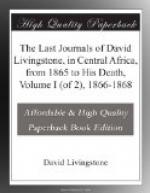2nd June, 1868.—In passing a field of cassava I picked the pods of a plant called Malumbi, which climbs up the cassava bushes; at the root it has a number of tubers with eyes, exactly like the potato. One plant had sixteen of these tubers, each about 2 inches long and 1-1/2 inch in diameter: another tuber was 5 inches long and 2 in diameter, it would be difficult for anyone to distinguish them from English potatoes. When boiled they are a little waxy, and, compared with our potato, hard. There are colours inside, the outer part reddish, the inner whiter. At first none of the party knew them, but afterwards they were recognised as cultivated at Zanzibar by the name “Men,” and very good when mashed with fish: if in Zanzibar, they are probably known in other tropical islands,
4th June, 1868.—From what I see of slaving, even in its best phases, I would not be a slave-dealer for the world.
5th June, 1868.—The Queen Moaeri passed us this morning, going to build a hut at her plantation; she has a pleasant European countenance, clean light-brown skin, and a merry laugh, and would be admired anywhere. I stood among the cassava to see her pass; she twirled her umbrella as she came near, borne by twelve men, and seemed to take up the laugh which made her and her maids bolt at my reception, showing that she laughs not with her mouth only, but with her eyes and cheeks: she said, “Yambo” (how are you)? To which I replied, “Tambo sana” (very well). One of her attendants said, “Give her something of what you have at hand, or in the pockets.” I said, “I have nothing here,” and asked her if she would come back near my hut. She replied that she would, and I duly sent for two strings of red beads, which I presented. Being lower than she, I could see that she had a hole through the cartilage, near the point of her slightly aquiline nose; and a space was filed between the two front teeth, so as to leave a triangular hole.
[Illustration: Filed Teeth of Queen Moaeri.]
After delay had grown vexatious, we march three hours on the 9th, and reach the Katofia River, covered with aquatic trees and running into the Mbereze: five yards wide and knee deep.
10th June, 1868.—Detained again, for business is not finished with the people of Casembe. The people cannot esteem the slave-trader, who is used as a means of punishing those who have family differences, as those of a wife with her husband, or a servant with his master. The slaves are said to be generally criminals, and are sold in revenge or as punishment. Kapika’s wife had an ornament of the end of a shell called the cone; it was borrowed and she came away with it in her hair: the owner, without making any effort to recover it, seized one of Kapika’s daughters as a pledge that Kapika would exert himself to get it back!
[At last the tedious delay came to an end and we must now follow the Doctor on his way south to discover Lake Bemba.]




